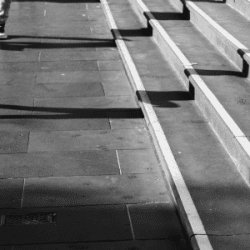Prayer, as anyone who does it regularly knows, is a path in and of itself. What we saw last week is that the great prayer masters didn't really care how you pray. The main thing is that you feel connected when you're praying. Prayer, if you remember to do it, will kindle your sense of the sacred, the sense of being held or taken care of by the universe.
Last week, we talked at length about the Asking Prayer, the prayer of petition. This week, we'll look at two other forms of prayer, and at the most inward form of prayer. Then we'll put it all together.
Prayer as Appreciation
Appreciative prayer includes every moment when we say thank you for the beauty in nature, or for the blessings in our life. It also includes every formal traditional prayer, from the Book of Psalms to the thousand names of Allah to the Rig Veda, as well as the highly creative practice of the monk Brother Lawrence, who simply spent the whole day talking to God.
Prayers of praise, appreciation, and gratitude feel good. They invite you into sacred feeling states, and can inject something ecstatic into even a downer moment. Try walking around with the prayer that a Bengali saint used, "Thank you, Mother, for becoming all this!" or just saying "Thank you" when you see something beautiful. Try saying "Thank you" when you're able to be of service, or just because you woke up this morning. As your appreciation prayer becomes habitual, you begin to feel more and more intimate with your life and the people in it. Your friends and partners will open up when they feel appreciated. So does the universe, in ways you can't know until you see it happening.
Prayers of Contrition
Less joyful, but equally profound as a means of connecting to the sacred, is the prayer of remorse and confession. Of course, every religious tradition has a formula for saying "I blew it. I'm sorry. Please forgive me and help me make amends." And formal confessional prayer can be sheer ritual, and a distracted one at that.
Yet again, it's a matter of connection. If you can fully enter into it, that moment of confession and contrition can be deeply life changing. Current yoga culture tends to overlook the spiritual power of remorse, perhaps because it's a reminder of the sin-and-repentance, self-castigating mold of our Puritan ancestors. For a contemporary Westerner with self-esteem issues, even the word 'confession' tends to bring up emotions like shame and guilt, which can feel anything but prayerful. Yet praying your remorse remains one of the great sacred technologies for dissolving the shadows that keep you from feeling like you deserve your spiritual gifts. Admitting a mistake—when it comes from a place of real feeling—is a kind of purifying fire that melts obstructions, known and unknown, so that even when you start off feeling small and stuck and uncomfortable with yourself, you emerge feeling transparent, re-united with your best self.
Confession doesn't have to be about what you've done wrong. You can confess your feelings of separation, or even practice what I call petitionary confession, as in "Please take away this fear, this cruelty, this feeling of unworthiness!" Confessional prayer is a form of housecleaning, a way of freeing up our inner space by letting go of the tendrils of regret and negative thinking.
In fact, in Hebrew, the word for 'confess' literally means revealing your inner state. So a confessional prayer might start by saying, "Here I am! I think I've been pretty loving today. I've done my best, and I'm opening my heart to grace!"
Deep Prayer
Through any of these forms of prayer, we can move from feeling the divine as separate, to feeling communion or close relationship, to the experience of merging into the object of prayer. This is when prayer becomes a form of worshipful meditation.
In the deepest states of prayer, the prayer-states that the mystics describe, the sense of separation melts away altogether, and you find yourself immersed in the heart. Any prayer can lead you to that state. The key is to allow the prayer to unfold, to let extraneous thoughts go as soon as you realize you're being distracted, and to cultivate the felt sense that you'll begin to recognize when you pray.
Prayer is, in the deepest sense, a practice of relationship. More than getting what you 'want', more than improving your emotional state, the practice of prayer can show you how deeply and fully you are being taken care of, protected, and loved. At its best, prayer can reveal love as the ground of your life.
Putting All This Together
You can use any one of these three forms of prayer alone. But most of the great prayer traditions recommend combining them, moving through them as 'stages' or steps, and then moving beyond them.
Get Quiet. Begin prayer by sitting in a posture as for meditation. If you like, you can fold your hands in anjali mudra, the posture of prayer. It's not necessary to kneel. Breathe into the heart, and connect your energy to the energy of the heart. The heart center is both the 'seat' of your subtle sense of existence, and also the traditional center for communion with the Presence.





